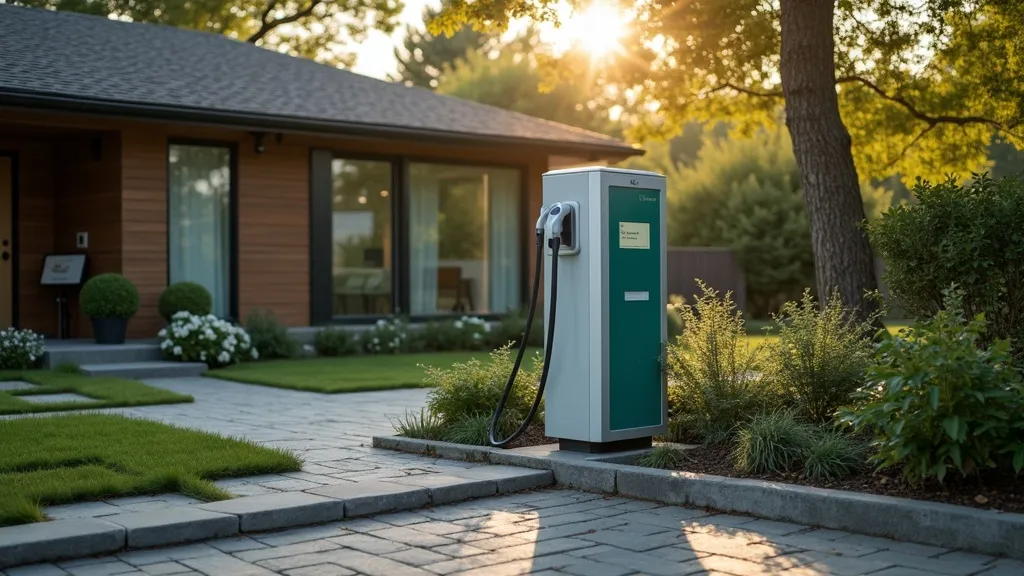Installing EV Charging Stations at Home
Installing an electric vehicle charging station in a shared residential building presents unique opportunities and challenges. As the demand for electric vehicles grows, so does the need for convenient charging solutions. Understanding key aspects, from technical requirements to legal frameworks and potential costs, aids in successful installations that benefit all residents in such settings.

Understanding the Basics of EV Charging Stations
As electric vehicles (EVs) become increasingly popular, the infrastructure for charging these vehicles must adapt to meet the growing demand. Installing an electric vehicle charging station in a shared residential building presents unique challenges. It involves careful planning, considering technical, legal, and financial aspects to ensure that all residents can benefit from the installation. This evolution of residential energy needs not only impacts individuals but also plays a crucial role in shaping the future landscape of urban design and community planning.
The transition to electric vehicle charging systems is being propelled by factors such as technological advancements, an increased environmental awareness, and government policies promoting green energy. However, the path to integrating charging stations within existing residential frameworks requires a multifaceted approach incorporating the unique dynamics of community living.
Technical Requirements for Installation
Before proceeding with the installation, it is crucial to assess the building's existing electrical capacity. Most apartment complexes are not initially designed to support EV charging stations, and this may require upgrades to the electrical system. Consultation with a certified electrician ensures that safety standards are met, and the system can handle additional power loads effectively.
Understanding the specific technical requirements is paramount to ensuring a seamless installation process. Here are a few detailed considerations:
- Power Supply: The power supply must be compatible with the charging station's power requirements and the building's capacity. This involves examining both the amperage and voltage needs of various charging station models. Common residential voltage standards include 120v and 240v systems, with most Level 2 chargers requiring 240v for optimal performance.
- Circuit Breaker: Installation may involve adding or upgrading circuit breakers to manage extra loads safely. Circuit breakers prevent electrical overloads and protect the wiring in the building, making it essential to consult with a licensed electrician to determine the best configuration and what kind of circuit breakers are necessary.
- Wiring: Proper wiring must extend from the main electrical panel to the charging point. This requires calculating the distance from the main panel to the proposed installation site, as longer distances may necessitate thicker wire gauges to avoid significant voltage drops, which can undermine charging efficiency.
- Charging Station Compatibility: It’s vital to select a charging station compatible with the majority of resident EV models. Popular brands such as Tesla, ChargePoint, and Blink should offer models that align with common EV charging standards.
| Component | Description |
|---|---|
| Power Supply | Must be compatible with the charging station's power requirements and the building's capacity. |
| Circuit Breaker | Installation may involve adding or upgrading circuit breakers to manage extra loads safely. |
| Wiring | Proper wiring must extend from the main electrical panel to the charging point. |
| Charging Station | Must match the charging needs of various EV models within the building, considering universal connectors. |
Navigating Legal and Regulatory Considerations
Legal requirements can vary significantly depending on location. Residents in shared buildings must often obtain approval from homeowners' associations or relevant governing bodies. Understanding local and state regulations plays a critical role in the approval process. Many locales now possess specific laws supporting the installation of EV charging stations, reflecting the push towards sustainable transportation.
Some essential legal considerations include:
- Homeowners' Association Bylaws: Review the bylaws or governing documents of the homeowners’ association (HOA). Some associations may have pre-existing rules regarding modifications to shared spaces that will influence the installation process.
- Tenant Agreements: In apartment buildings, checking tenant agreements is crucial. Any agreements regarding property modifications or installations must be respected to avoid potential disputes.
- Zoning Laws: Research applicable zoning laws which dictate the use of properties for EV charging installations. Some areas require a special use permit, especially if charging units are being placed in common areas.
- Utility Regulations: Consult with utility companies for regulations and potential rebates. Some utilities promote EV adoption by providing incentives or rebates for individuals who install charging stations.
Furthermore, some regions offer incentives or rebates for installing EV charging stations, which can offset initial costs. These incentives may come from local government programs aimed at reducing carbon footprints, promoting sustainable energy, or enhancing electric vehicle usage in urban areas. Taking the time to research available grants or financial assistance can significantly diminish the financial burden on both residents and property owners.
Cost Implications and Financial Planning
The cost of installing a charging station varies, depending on several factors such as the complexity of installation, the need for electrical upgrades, and the type of station chosen. Costs can also fluctuate based on labor rates, local permitting fees, and the specific configuration that meets community needs. Understanding these costs in advance allows for better financial planning and smoother installations.
Cost Breakdown:
Installation Cost Breakdown:
- Level 1 Charger: Typically costs between $300 - $600 for the unit, with installation fees ranging from $150 to $300. Level 1 chargers use standard household plugs and generally do not require extensive electrical upgrades.
- Level 2 Charger: Prices range from $500 to $2,200, excluding potential electrical upgrades that can vary significantly in cost. Level 2 chargers provide faster charging times, making them more suitable for communal living but often necessitate a stronger electrical setup.
When planning for charges, it is also essential to consider the ongoing maintenance costs and potential costs associated with electricity consumption. For communal chargers, these costs might need equitable distribution among residents.
Beyond installation costs, it’s essential to examine potential financial arrangements. Some installations can be funded by charging fees from users, which generate ongoing revenue that may even cover future maintenance costs. Charging by the kilowatt-hour or offering a monthly fee could be viable financial options to consider among residents.
Installation Steps and Considerations
- Initial Assessment: Evaluate the building's current electrical infrastructure. This step includes evaluating load capacities, existing wiring, and potential upgrade needs. Documentation of current practices and systems also aids in the planning process.
- Proposal Submission: Prepare and submit a proposal or application to the relevant authority in the building, such as the HOA or apartment management. This proposal should detail the benefits of the installation and outline any incentives being sought from local governments.
- Approval and Permits: Obtain necessary approvals and permits for installation, including local zoning, electrical, and building permits. This step may require several meetings with the HOA and coordination with city officials, so patience and thorough communication are essential.
- Choosing Professionals: After obtaining the necessary permits, hire qualified professionals to install the charging station. Obtaining bids from multiple contractors not only provides insight into potential costs but can also ensure that certified electricians complete the work.
- Testing and Activation: Conduct testing to ensure proper function and safety before activation. This final step often involves inspections from local building authorities to verify that all local codes were met, ensuring the charging station operates safely and effectively.
Post-Installation Maintenance
Once the charging stations are installed, ongoing maintenance is crucial to ensure their effectiveness and safety. Regular checks should include:
- Visual Inspections: Conduct frequent visual assessments to look for any physical damage or wear to the charging units. Simple checks can help identify rust, loose connections, or potential hazards.
- Functionality Tests: Monthly functionality tests of units ensure that they are charging as expected. If discrepancies arise, contacting servicing teams promptly prevents prolonged outages.
- Software Updates: For smart chargers, regular software updates can provide improved performance, increased security features, and bug fixes. Some manufacturers may offer options for automatic updates, while others might require manual checks.
FAQs on Installing EV Charging Stations at Home
Q1: Is permission needed from all residents in the building?
A1: Typically, approval is required from the homeowners' association or a similar governing body within the building. The specific requirements may vary based on local regulations. It is beneficial to hold community meetings discussing the overall benefits and responsibilities associated with shared charging stations.
Q2: What incentives are available for installing EV charging stations?
A2: Some regions offer tax incentives, rebates, or grants to encourage the installation of EV infrastructure. Checking with local authorities or utility companies can provide specific information. Additionally, many local blackouts or high-demand times may lower incentives but are often seasonal, where renewable energy supports overall consumption.
Q3: How long does the installation process take?
A3: The timeline can vary based on the complexity of the installation and the need for any additional permits or approvals. Generally, it can take anywhere from a few days to a few weeks. Planning ahead and collaborating with residents can expedite decision-making processes.
Q4: What are the potential liabilities with charging stations?
A4: Liability can hinge on local laws and the specific agreements made regarding the installation and use of charging stations. To mitigate risk, many HOA agreements now contain language outlining the responsibilities and fees associated with charging facilities. Engaging legal counsel to prepare documentation can safeguard against potential disputes.
Benefits of EV Charging Stations in Residential Buildings
Integrating EV charging stations into residential buildings presents a variety of tangible benefits:
- Increased Property Value: Properties that feature EV charging stations tend to attract a growing segment of eco-conscious buyers, thereby increasing their market demand. Studies have shown that homes equipped with electric vehicle charging infrastructure maintain a higher value over properties without such amenities.
- Environmental Impact: The installation of EV charging stations promotes the use of sustainable vehicles. This is a significant factor in reducing carbon footprints and enhancing air quality, especially in urban environments where traffic pollution is a major concern.
- Community Connectivity: Establishing EV charging stations encourages a sense of community. Residents may work together on shared sustainability efforts and foster relationships by collectively addressing the goals of reducing energy consumption.
- Future Preparedness: With the forecast predicting continual growth in EV adoption, providing charging infrastructure prepares buildings to accommodate future residents’ needs. Investing in charging capabilities signals an awareness of technological advances and positions properties ahead of the curve.
Understanding and navigating the nuances of installing an electric vehicle charging station in a shared residential building requires thorough preparation and collaboration with all stakeholders. Such an investment enhances property value, significantly contributes to a sustainable environment, and closely aligns residents with the growing trend towards sustainable transportation. By approaching the installation process holistically and inclusively, stakeholders can ensure the benefits extend far beyond mere convenience, shaping the future of residential living.
-
1

Ultimate Feast for the Eyes: Top Cooking Shows Every Foodie Must Watch!
-
2

Maximize the Lifespan of Your New Dental Implants with Expert Care Tips
-
3

Ascending with Ease: The Revolutionary Journey of Stair Lift Technology
-
4

Maximizing Your Walk-In Tub's Lifespan: The Ultimate Guide to Enhanced Performance and Durability
-
5

Unlock Bigger Savings: Master the Art of Using Your Gas Rebate Card!










